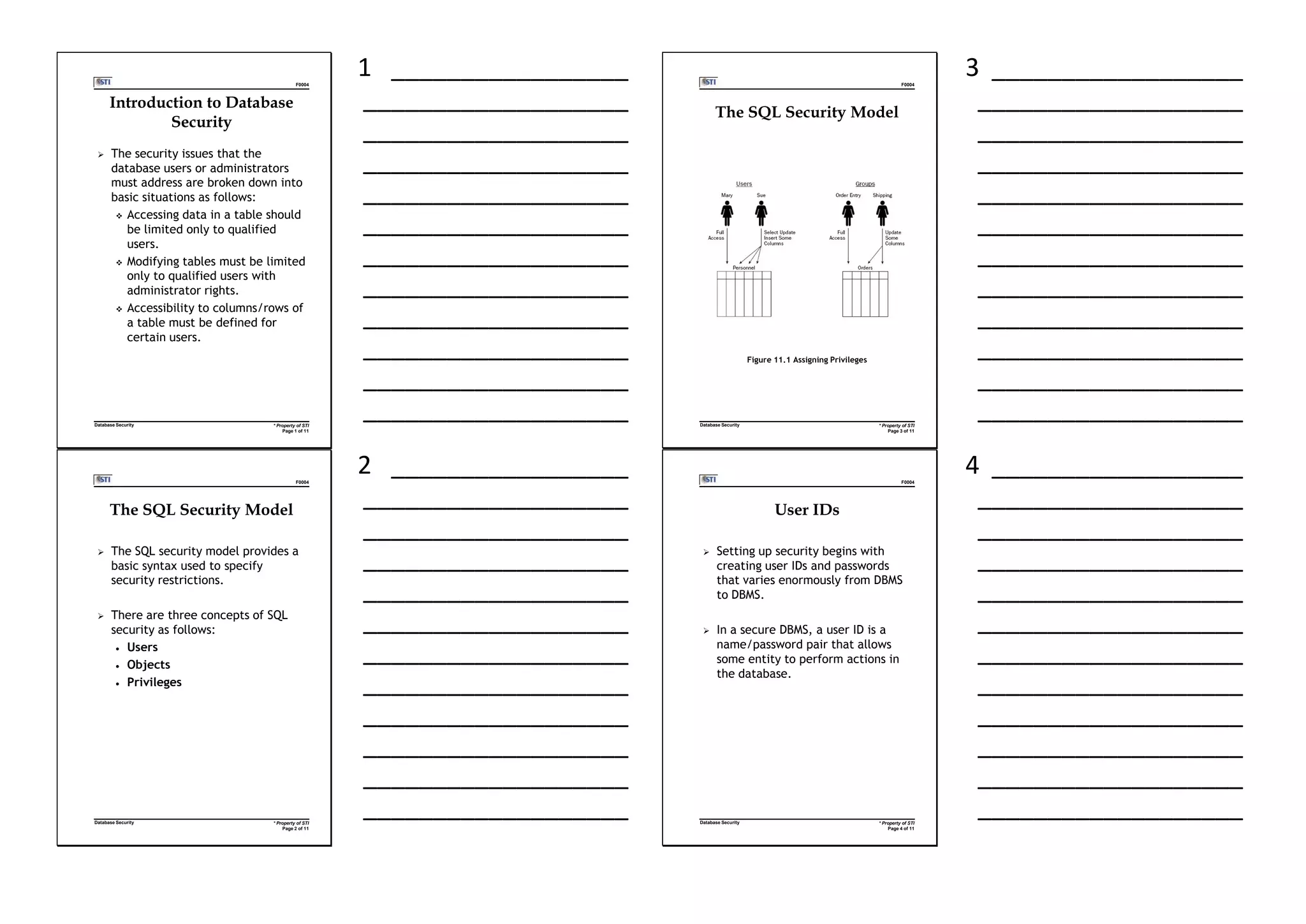The document discusses database security and describes how to implement security through assigning user privileges. It introduces basic database security concepts such as users, objects, and privileges. It also provides the syntax for SQL statements to create users, grant privileges to users, and revoke privileges.

![F0004
* Property of STI
Page 5 of 11
Database Security
Objects
The SQL standard defines security
in terms of objects to which
actions are performed.
In the SQL1 standard, the only
objects that security is applied are
tables and views.
Figure 11.2 Using Grant
5 _________________
___________________
___________________
___________________
___________________
___________________
___________________
___________________
___________________
___________________
___________________
___________________
F0004
* Property of STI
Page 7 of 11
Database Security
Privileges
There are two types of privileges:
System privileges
Object privileges
SQL supports the following object
privileges:
SELECT
INSERT
DELETE
UPDATE
REFERENCES
ALTER
INDEX
7 __________________
___________________
___________________
___________________
___________________
___________________
___________________
___________________
___________________
___________________
___________________
___________________
F0004
* Property of STI
Page 6 of 11
Database Security
Privileges
Privileges are issued via the GRANT
command and are taken away via
the REVOKE command.
The privileges that can be granted
are divided into four groups:
Column privileges relate to one
specific column of a table.
Table privileges relate to all
data of one specific table.
Database privileges relate to all
tables of one specific database.
User privileges relate to all
databases that are known to
SQL.
6 _________________
___________________
___________________
___________________
___________________
___________________
___________________
___________________
___________________
___________________
___________________
___________________
F0004
* Property of STI
Page 8 of 11
Database Security
Adding Users
Some DBMSs have SQL statements,
extensions to the SQL standard
specific to that DBMS that allow
creating users.
In Oracle the statement is as
follow:
CREATE USER username
IDENTIFIED {BY password |
EXTERNALLY | GLOBALLY AS
external_name}
Options
In Sybase, the syntax is as follow:
GRANT CONNECT TO userid , . . .
[ AT starting-id ]
IDENTIFIED BY password, . . .
8 __________________
___________________
___________________
___________________
___________________
___________________
___________________
___________________
___________________
___________________
___________________
___________________](https://image.slidesharecdn.com/09ohpslidehandout1-150908152339-lva1-app6891/75/Database-Security-Handout-2-2048.jpg)
![F0004
* Property of STI
Page 9 of 11
Database Security
Granting Privileges
The basic GRANT statement is used to
grant security privileges on database
objects to specific users or, in some DBMS
implementations, to groups.
The syntax is as follow:
GRANT {
ALL [ PRIVILEGES ],
ALTER,
DELETE,
INSERT,
REFERENCES [ ( column-
name, . . . ) ],
SELECT [ ( column-name, . . . ) ],
UPDATE [ ( column-name, . . . ) ],
}
ON [ owner.]table-name
TO userid , . . .
[ WITH GRANT OPTION ]
[ FROM userid ]
9 _________________
___________________
___________________
___________________
___________________
___________________
___________________
___________________
___________________
___________________
___________________
___________________
F0004
* Property of STI
Page 11 of 11
Database Security
Revoking Privileges
Use the REVOKE statement if you have granted
privileges and later you need to revoke these
privileges.
Syntax 1
REVOKE special-priv , . . . FROM
userid , . . .
special-priv :
CONNECT
Syntax 2
REVOKE table-priv , . . . ON
[ owner.]table-name FROM
userid , . . .
table-priv :
ALL [PRIVILEGES]
| ALTER
| DELETE
| INSERT
| REFERENCES [ ( column-name, . . . ) ]
| SELECT [ ( column-name, . . . ) ]
| UPDATE [ ( column-name, . . . ) ]
11 _________________
___________________
___________________
___________________
___________________
___________________
___________________
___________________
___________________
___________________
___________________
___________________
F0004
* Property of STI
Page 10 of 11
Database Security
Granting Privileges
Example:
GRANT
SELECT, UPDATE ( street )
ON employee
TO Laurel
10 ________________
___________________
___________________
___________________
___________________
___________________
___________________
___________________
___________________
___________________
___________________
___________________](https://image.slidesharecdn.com/09ohpslidehandout1-150908152339-lva1-app6891/75/Database-Security-Handout-3-2048.jpg)